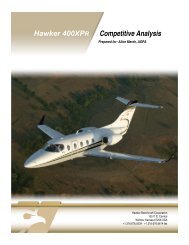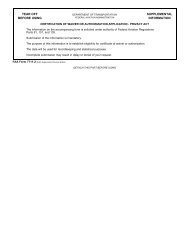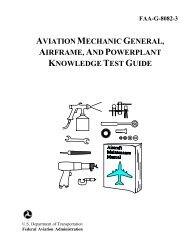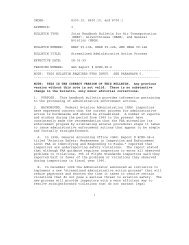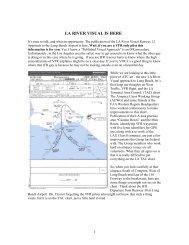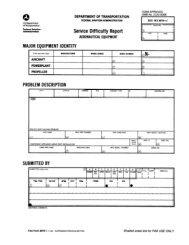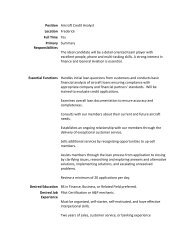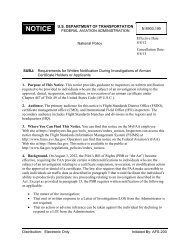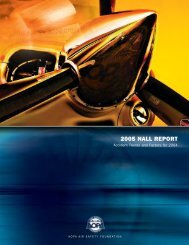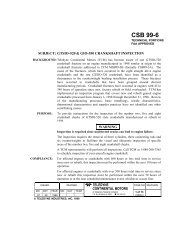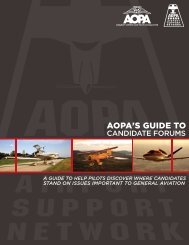2008 Nall Report - Aircraft Owners and Pilots Association
2008 Nall Report - Aircraft Owners and Pilots Association
2008 Nall Report - Aircraft Owners and Pilots Association
Create successful ePaper yourself
Turn your PDF publications into a flip-book with our unique Google optimized e-Paper software.
ACCIDENT FACTORS<br />
Single-engine fixed-gear aircraft accounted for 122<br />
of the 151 takeoff accidents (80.8 percent) <strong>and</strong><br />
almost half of these (60) were conventional-gear<br />
(tailwheel) airplanes. Another two involved retractable<br />
single-engine tailwheel aircraft, involving<br />
conventional l<strong>and</strong>ing gear in a total of 41.1 percent<br />
of all takeoff accidents. While complete statistics<br />
on the proportion of the hours flown in conventional<br />
gear airplanes are not available, available<br />
data suggests that it’s considerably less than half<br />
the fleet total; the increased skill level required to<br />
take off <strong>and</strong> l<strong>and</strong> in these airplanes is a likely reason<br />
for their high involvement in takeoff accidents.<br />
Only seven takeoff accidents (4.6 percent) involved<br />
multiengine aircraft. Takeoff <strong>and</strong> climb accidents<br />
in multiengine aircraft were relatively scarce (9 of<br />
162, or 5.6 percent) but lethal; five of nine (55.6<br />
percent) were fatal, compared to 25 of 153 (16.3<br />
percent) in single-engine aircraft.<br />
The number of takeoff <strong>and</strong> climb accidents was<br />
roughly proportionate to the percentage of overall<br />
flying for each type of operation. Including three<br />
accidents at dawn, almost all (148, 91.4 percent)<br />
takeoff <strong>and</strong> climb accidents took place in daytime<br />
VMC. All the fatal accidents occurred during daylight<br />
hours, 27 of them (90 percent) in VMC. Six<br />
accidents, three of which were fatal, took place<br />
in daytime IMC; <strong>and</strong> five nonfatal accidents were<br />
at dusk <strong>and</strong> three were at night. One of those occurred<br />
in instrument conditions.<br />
Maneuvering<br />
91 total/51 fatal<br />
Typical maneuvering accidents occur for one or<br />
more of the following reasons:<br />
• Stall or Loss of Control – Loss of airspeed during<br />
the maneuvering can result in a stall/spin or<br />
other loss of control.<br />
Accident Case Study<br />
DFW07LA124<br />
Amateur-Built RV-6A, Boerne, Texas<br />
One fatality<br />
History of Flight<br />
The commercial pilot lost control of the single-engine<br />
amateur-built airplane during takeoff from a private 2,300-<br />
foot long turf runway. Witnesses reported that the airplane<br />
appeared to have made a normal takeoff. At about 100 to<br />
150 feet above the ground the airplane was observed to<br />
have attained a pronounced nose-high attitude, <strong>and</strong> subsequently<br />
rolled abruptly to the left as the airplane assumed a<br />
nose-low attitude. The airplane impacted the ground in the<br />
inverted position. A post-impact fire consumed most of the<br />
airplane. At the time of the accident, the density altitude<br />
was calculated to be 3,126 feet.<br />
Pilot Information<br />
The pilot, age 39, was a former Naval aviator <strong>and</strong> active<br />
helicopter pilot in the Naval Reserve. He held a commercial<br />
certificate with instrument rating for single-engine airplanes<br />
<strong>and</strong> helicopters <strong>and</strong> commuted daily in the accident aircraft.<br />
He had 1,798 hours of flight experience, most of it in helicopters,<br />
<strong>and</strong> 250 hours time in type.<br />
Weather<br />
Sky condition was 2,400 broken, visibility 10 statute miles.<br />
Winds were from 180 degrees at 10 knots.<br />
Probable Cause<br />
The pilot’s failure to maintain the best angle of climb speed<br />
resulting in an inadvertent stall. A contributing factor was<br />
the high density altitude.<br />
ASF Comments<br />
Use of the proper climb speeds is critical to ensure safety<br />
<strong>and</strong> maximum airplane performance when operating from<br />
short runways.<br />
• Wire Strikes <strong>and</strong> Structure Impacts – If maneuvering<br />
is conducted at extremely low altitudes, collisions<br />
with wires or other structures is likely.<br />
• Mountain or Canyon Impacts – Terrain impact<br />
is another possible result when maneuvering at<br />
very low altitudes.<br />
• Aerobatics – Conducting aerobatics with improper<br />
training or equipment, or at unsafe altitudes,<br />
is a high-risk operation.<br />
19



